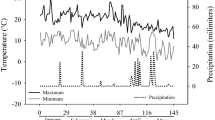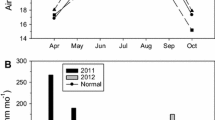Abstract
Blackwood (Acacia melanoxylon R. Br.) is a species with poor apical dominance, and in plantations, silvicultural interventions are required to improve stem form. Planting blackwood with a nurse crop and pruning to remove large branches and multiple leaders are common methods used in blackwood plantations. An experiment was established to determine whether applications of nitrogen (N), phosphorus (P) or magnesium (Mg) could also be used to improve stem growth and form. Other aims of the experiment were to compare responses of the blackwood and the Pinus radiata D. Don nurse crop to fertiliser application, and to identify changes in blackwood physiology resulting from fertilising.
Application of P had a more marked positive effect on blackwood stem growth than application of N or the combination of N and P. Mg had no effect on stem growth. The response to P may have been related to a substantial increase in root nodulation and a 35% increase in coarse root dry mass. Foliar nutrient analysis suggested that these responses led to an improvement in plant nutrition. In contrast N application reduced root nodulation by 60%. P application improved stem form in the short term by increasing biomass partitioning to stems at the expense of branches. However this response was no longer apparent 24 months after fertilising, suggesting that frequent applications of P may be necessary for long-term improvements in stem form. While light-saturated CO2 assimilation was increased by applications of N, this was not translated into greater biomass production, probably because of shading of many of the blackwood crowns by the nurse crop. The P. radiata nurse crop responded to fertilising differently to the blackwood, with greatest growth increases following application of either the combination of N and P or Mg alone. This highlights the need to understand responses to fertilising of both blackwood and the nurse crop. The most favourable nurse crop:blackwood height ratio was observed following P application, meaning that this treatment is the least likely to result in suppression of the blackwood by the nurse crop.





Similar content being viewed by others
References
Allen D (1992) Blackwood plantations in Tasmania. Forestry Commission Tasmania, Hobart, p 88
Barton I (1993) A system for Blackwood – Acacia melanoxylon. A farm forester's experience. Tree Grower, New Zealand Farm Forestry Association, pp 11–16
Bauhus J, Khanna PK, Mendham N (2000) Aboveground and belowground interactions in mixed plantations of Eucalyptus globulus and Acacia mearnsii. Can J For Res 30:1886–1894
Binkley D, Giardina C (1997) Nitrogen fixation in tropical forest plantations. In: Nambiar EKS, Brown AG (eds) Management of soil, nutrients and water in tropical plantation forests. ACIAR Monograph No. 43. ACIAR, Canberra
Boland DJ, Brooker MIH, Chippendale GM, Hall N, Hyland BPM, Johnston RD, Kleinig DA , Turner JD (1994) Forest trees of Australia. Thomas Nelson, Australia, and CSIRO
Brodribb T, Hill RS (1993) A physiological comparison of leaves and phyllodes in Acacia melanoxylon. Am J Bot 41:293–305
Cannell MGR (1985) Dry matter partitioning in tree crops. In: Cannell MGR, Jackson JE (eds) Attributes of trees as crop plants. Institute of Terrestrial Ecology, pp 160–193
Cannell MGR, Dewar RC (1994) Carbon allocation in trees: a review of concepts for modelling. Adv Ecol Res 25:59–104
Cobbina J (1991) Nitrogen and phosphorus fertilization promotes rapid initial growth of Leucaena on alfisol. Commun Soil Sci Plant Anal 22:1–9
Duguma B, Kang BT, Okali DUU (1988) Effect of liming and phosphorus application on performance of Leucaena leucocephala in acid soils. Plant Soil 110:57–61
Evans JR (1989) Photosynthesis and nitrogen relationships in leaves of C3 plants. Oecologia 78:9–19
Gonzalez EM, Aparico-Tejo PM, Gordon AJ, Minchin FR, Royuela M, Arrese-Igor C (1998) Water-deficit effects on carbon and nitrogen metabolism of pea nodules. J Exp Bot 49:1705–1714
Herbert MA (1984) Variation in the growth of and responses to fertilizing black wattle with nitrogen, phosphorus, potassium and lime over three rotations. In: Conference proceedings of symposium on site and productivity of fast growing plantations. Pretoria and Pietermaritzburg, South Africa. International Union of Forestry Research Organisations
Ingestad T (1980) Growth, nutrition and nitrogen fixation in grey alder at varied rate of nitrogen addition. Physiol Plantarum 50:353–364
Israel DW (1987) Investigation of the role of phosphorus in symbiotic dinitrogen fixation. Plant Physiol 84:835–840
Knight PJ (1986) Phosphorus and sulphur requirements of blackwood (Acacia melanoxylon R. Br.) seedlings. Commun Soil Sci Plant Anal 17:1121–1145
McPherson G (1990) Statistics in scientific investigation. Its basis, application and interpretation. Springer, London
Medhurst J, Worledge D (2001) Silvicultural options for plantation-grown Acacia melanoxylon: Form Pruning and Nurse Crop Thinning. CRC Sustainable Production Forestry technical report 50, CRC, Hobart, Australia, p 12
Medhurst JL, Beadle CL (2000) Crown structure and leaf area index development in thinned and unthinned Eucalyptus nitens plantations. Tree Physiol 21:989–999
Messina MG, Barton IL (1985) Early growth and survival of Acacia melanoxylon: effect of weed control and fertiliser. New Zealand Journal of Forestry Science 15:111–116
Mrema AF, Granhall U, Sennerby-Forsse L (1997) Plant growth, leaf water potential, nitrogenase activity and nodule anatomy in Leucaena leucocephala as affected by water stress and nitrogen availability. Trees 12:42–48
Naidu R, Tillman RW, Syers JK, Kirkman JH (1990) Lime-aluminium-phosphorus interactions and the growth of Leucaena leucocephala. Plant Soil 126:1–8
Neilsen WA (1990) Plantation handbook. Forestry Commission Tasmania, Hobart, Australia, p 290
Neilsen WA, Brown DR (1996) Acacia melanoxylon plantations in Tasmania. Forestry Tasmania internal report, Hobart, p 193
Nicholas I, Gifford H (1995) Form pruning Australian Blackwood (Acacia melanoxylon) – NZ FRI experience, New Zealand Forest Research Institute notesheet
Nicholas ID (1988) The silviculture of blackwood in New Zealand. In: Proceedings of the international forestry conference for the Australian bicentennary 1988, Albury-Wodonga
Pinkard EA, Beadle CL (2002) Blackwood (Acacia melanoxylon) plantation silviculture: a review. Aust For 65:7–13
Rayment GE, Higginson FR (1992) Australian laboratory handbook of soil and water chemical methods. Inkata Press, Melbourne, p 330
Sands PJ (1995) Modelling canopy production. I. Optimal distribution of photosynthetic resources. Aust J Plant Physiol 22:593–601
Sprugel DG (1983) Correcting for bias in log-transformed allometric equations. Ecology 64:209–210
Unwin G, Jennings S, Hickey J, Denholm G (2001) Blackwood regrowth and the forest light environment - the key to good form. In: Conference proceedings of silvicultural management of Blackwood, Smithton, Tasmania. Publication No. 01/176, Rural Industries Research and Development Corporation, pp 5–9
Vogt K, Asvjornsen H, Erclawn A, Montagnini F, Valdés M (1997) Roots and mycorrhizas in plantation ecosystems. In : Nambiar EKS, Brown AG (eds) Management of soil, nutrients and water in tropical plantations. Australian Centre for International Agricultural Research, Canberra, Australia, pp 247–296
Waki K (1984) The growth and the nutrient status of Acacia species in Japan. In: Proceedings of symposium on site and productivity of fast growing plantations. Pretoria and Pietermaritzburg, South Africa. International Union of Forestry Research Organisations
Wolf B (1971) The determination of boron in soil extracts, plant materials, composts, manures, water and nutrient solutions. Soil Sci Plant Anal 2:363–374
de Zwaan JG (1981) Silviculture of blackwood (Acacia melanoxylon). Saasveld Forestry Research Institute, George, South Africa, p 20
Acknowledgements
Many thanks to the following for their assistance in field work and biomass sampling: Bill Neilsen, Carolyn Ringrose, Martin Piesse, Sven Meyer, Dion McKenzie, Jacinta Lesek and Lindsay Wilson. The Cooperative Research Centre for Sustainable Production Forestry provided use of its planimeter and infra red gas analyser.
Author information
Authors and Affiliations
Corresponding author
Rights and permissions
About this article
Cite this article
Pinkard, E.A. Growth and physiological responses of Blackwood (Acacia melanoxylon) growing with a Pinus radiata nurse crop following applications of nitrogen and phosphorus. Trees 17, 325–335 (2003). https://doi.org/10.1007/s00468-002-0242-y
Received:
Accepted:
Published:
Issue Date:
DOI: https://doi.org/10.1007/s00468-002-0242-y




